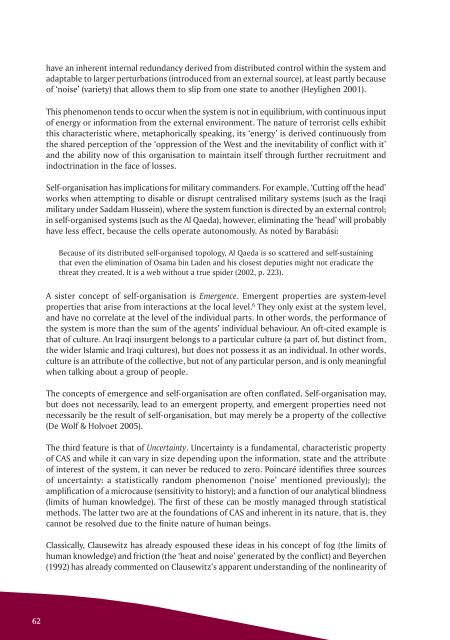ISSUE 176 : Jul/Aug - 2008 - Australian Defence Force Journal
ISSUE 176 : Jul/Aug - 2008 - Australian Defence Force Journal
ISSUE 176 : Jul/Aug - 2008 - Australian Defence Force Journal
You also want an ePaper? Increase the reach of your titles
YUMPU automatically turns print PDFs into web optimized ePapers that Google loves.
have an inherent internal redundancy derived from distributed control within the system and<br />
adaptable to larger perturbations (introduced from an external source), at least partly because<br />
of ‘noise’ (variety) that allows them to slip from one state to another (Heylighen 2001).<br />
This phenomenon tends to occur when the system is not in equilibrium, with continuous input<br />
of energy or information from the external environment. The nature of terrorist cells exhibit<br />
this characteristic where, metaphorically speaking, its ‘energy’ is derived continuously from<br />
the shared perception of the ‘oppression of the West and the inevitability of conflict with it’<br />
and the ability now of this organisation to maintain itself through further recruitment and<br />
indoctrination in the face of losses.<br />
Self-organisation has implications for military commanders. For example, ‘Cutting off the head’<br />
works when attempting to disable or disrupt centralised military systems (such as the Iraqi<br />
military under Saddam Hussein), where the system function is directed by an external control;<br />
in self-organised systems (such as the Al Qaeda), however, eliminating the ‘head’ will probably<br />
have less effect, because the cells operate autonomously. As noted by Barabási:<br />
Because of its distributed self-organised topology, Al Qaeda is so scattered and self-sustaining<br />
that even the elimination of Osama bin Laden and his closest deputies might not eradicate the<br />
threat they created. It is a web without a true spider (2002, p. 223).<br />
A sister concept of self-organisation is Emergence. Emergent properties are system-level<br />
properties that arise from interactions at the local level. 6 They only exist at the system level,<br />
and have no correlate at the level of the individual parts. In other words, the performance of<br />
the system is more than the sum of the agents’ individual behaviour. An oft-cited example is<br />
that of culture. An Iraqi insurgent belongs to a particular culture (a part of, but distinct from,<br />
the wider Islamic and Iraqi cultures), but does not possess it as an individual. In other words,<br />
culture is an attribute of the collective, but not of any particular person, and is only meaningful<br />
when talking about a group of people.<br />
The concepts of emergence and self-organisation are often conflated. Self-organisation may,<br />
but does not necessarily, lead to an emergent property, and emergent properties need not<br />
necessarily be the result of self-organisation, but may merely be a property of the collective<br />
(De Wolf & Holvoet 2005).<br />
The third feature is that of Uncertainty. Uncertainty is a fundamental, characteristic property<br />
of CAS and while it can vary in size depending upon the information, state and the attribute<br />
of interest of the system, it can never be reduced to zero. Poincaré identifies three sources<br />
of uncertainty: a statistically random phenomenon (‘noise’ mentioned previously); the<br />
amplification of a microcause (sensitivity to history); and a function of our analytical blindness<br />
(limits of human knowledge). The first of these can be mostly managed through statistical<br />
methods. The latter two are at the foundations of CAS and inherent in its nature, that is, they<br />
cannot be resolved due to the finite nature of human beings.<br />
Classically, Clausewitz has already espoused these ideas in his concept of fog (the limits of<br />
human knowledge) and friction (the ‘heat and noise’ generated by the conflict) and Beyerchen<br />
(1992) has already commented on Clausewitz’s apparent understanding of the nonlinearity of<br />
62

















